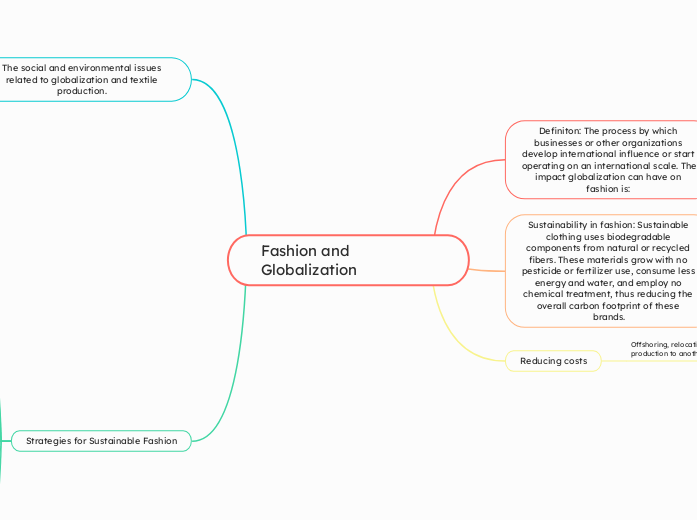Fashion and Globalization
Definiton: The process by which businesses or other organizations develop international influence or start operating on an international scale. The impact globalization can have on fashion is:
Global supply chains allow for cheaper production costs.
Brands can reach a global audience through market expansion
Different cultures have an influence on fashion trends.
Sustainability in fashion: Sustainable clothing uses biodegradable components from natural or recycled fibers. These materials grow with no pesticide or fertilizer use, consume less energy and water, and employ no chemical treatment, thus reducing the overall carbon footprint of these brands.
Eco-Friendly Materials like the use of organic materials, recycled, natural fibers like plants and biodegradable materials.
Sustainably produced materials because of the use of resources and energy which reduces waste.
Renewable because they recycle and upcycle clothing to extend the lifecycle.
Reducing costs
Offshoring, relocating business processes or production to another country to reduce costs.
The social and environmental issues related to globalization and textile production.
Fast fashion: inexpensive clothing produced rapidly by mass-market retailers in response to the latest trends.
Repetitive flow production.
Pollution due to chemical runoff and greenhouse gasses.
Workers health issues because they lack financial stability from not getting paid enough. They may not be able to afford basic necessities.
Labor regulations
No more sweatshops
Labor costs
Fair trade: There should be fair wages to prevent this and promoting products that meet Fair Trade standards
Human rights violations
Child labor
Bad working conditions
To prevent this, there should be health and safety regulations
Low quality garments
Benefits of fast fashion
Large quantities produced and rapid production.
Affordable.
Short production cycles.
Environmental issues in the textile production process
Textile Dyeing: The process of coloring fabrics, which can lead to significant water pollution.
Water emissions
Carbon Emissions: The energy-intensive processes contribute to high levels of carbon dioxide and other greenhouse gases.
Textile disposal
Air emissions
Greenhouse gas emissions from transportation of raw materials and finished products.
Many textiles are produced in developing countries with less stringent environmental regulations.
Ways to prevent the environmental issues in the textile production process
Just in time production
boycotts
Refusing to buy products from companies that engage in harmful environmental practices, pressuring them to change.
Government Regulations: Implementing and enforcing laws that limit pollution and resource use in textile production.
Strategies for Sustainable Fashion
Produce and sell items locally
Outsourcing
Buying less
Reduce continuous flow production
Minimize pollution
Greening
The role of tariffs in promoting sustainable practices.
USMCA Trade Agreement: Impact on textile trade and production standards among the member countries.
Innovations in producing yarns with lower environmental impact.
